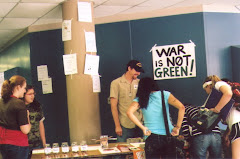
Monday, January 26, 2009
Peaceful Vocations group marches in Ft. Worth

Wednesday, January 21, 2009
Spinning the peace wheel at the MLK Day Festival

People achieving justice, peace and freedom through creative nonviolence
Gator is an award-winning poet and emcee in Austin who was president of his class at Reagan High School. He has been active with the Texas Youth Word Collective and his band, Public Offender.
Bernice Johnson Reagon is a composer, scholar, educator, performer and founder of the African American a cappella group, Sweet Honey in the Rock. As a college student, she was active in the Civil Rights Movement and was an original member of the SNCC (Student Nonviolent Coordinating Committee) Freedom Singers in 1962.
Martin Luther King, Jr. (1929 – 1968) is perhaps the best known of all US Civil Rights leaders. Following methods used by Gandhi and the freedom movement in India, King’s oratory, writings and personal example directed the movement in using nonviolent strategies such as mass marches, boycotts, sit-ins and direct negotiations in achieving equal rights.
John Lennon (1940 – 1980) was a member of the British rock band, The Beatles, and also had a successful solo career. He and his spouse, Yoko Ono were outspoken peace advocates who expressed their views through music and performance art.
Aung San Suu Kyi is a Nobel peace laureate and leader of the National League for Democracy in Burma who has lived under house arrest in Burma/Myanmar for some 15 years. Even though the government is ruled by a military junta, she is considered a leader by the Burmese people and continues to urge nonviolent resistance to the regime.
Cesar Chavez (1927 – 1993) led worker strikes, boycotts and marches for higher wages and better working conditions for agricultural workers in the US, including South Texas. He and Dolores Huerta co-founded the United Farm Workers, led the successful California grape boycott and helped organize other labor organizations in Texas and the Midwest. A statue of Chavez stands on the UT campus.
Julia Butterfly Hill is a poet, speaker and environmental activist who lived for two years on a platform 18 stories high in a 1,000 year-old redwood tree in California as a protest against clear-cutting. Her book about that experience, The Legacy of Luna, was published in 2000.
Flobots is a rock/hip-hop band based in Denver. Their lyrics promote nonviolent social change. Their current release is Fight With Tools.
Mohandas Gandhi (1869 – 1948) was one of the most influential nonviolent activists in history. He helped lead India to independence from British Colonial Rule and his nonviolent methods inspired MLK and others in the US Civil Rights Movement.
Helen Keller (1880 –1968) was the first deafblind person to graduate from college. She learned to speak and became a world traveler and author who was outspoken in her advocacy for peace, women’s voting rights and labor rights.
Barbara Jordan (1936 – 1996) was an attorney who, in 1966, became the first African- American woman voted into the Texas Senate and, in 1972, the first black woman from a southern state voted into the US House of Representatives. She later taught at the LBJ School for Public Affairs in Austin.
Research shows trends in recruiting
National Priorities Project (NPP) finds significant gap in Army's 2008 quantity and quality goals
Online Tool Allows the Public to Analyze Army Data by State, County, Zip Code, Education Level, “Quality of Recruit”
NORTHAMPTON, MA – A new NPP analysis highlights a significant gap in the Army's 2008 quantity and quality goals. Using census material, combined with data on 2008 Army enlistment obtained through a Freedom of Information Act, NPP research also uncovers a continued trend of disproportionate recruits from southern states.
This work is a result of an expanded NPP initiative, which now includes a database of 2004-2008 military recruitment numbers broken down by zip code, county and state. A snapshot analysis and overview of current military recruitment data, which includes a ranking of counties by recruits per thousand youth, charts and tables on a particular county, zip code or state is available at www.nationalpriorities.org.
“Analysts project a $60 billion increase in the 2010 defense budget, largely tied to increasing troop levels. This increase does not include a six month supplemental funding request to pay for the US wars in Afghanistan and Iraq, which is expected to approach, if not exceed $70 billion,” notes Suzanne Smith, Research Director for National Priorities Project. “These budget figures, combined with a call for increased troop numbers, are striking in light of a report recently issued by a Pentagon advisory group which noted that 'rising costs of military personnel, their healthcare and overhead' exacerbated the problem of an 'unsustainable' Defense Department budget in tough economic times.”
NPP's new data shows:
- While the army claims 80,517 new army recruits this year, surpassing its goal of 80,000, in actuality, its figures reflect the number of individuals with whom they have some form of – often non-binding – contract. The number of accessions, or actual recruits who reported for duty in 2008, was 69,357.
- The percent of Tier 1 recruits, at 74% is 16 percentage points below the army's goal of 90%. This is the fourth year running that the army has missed its “quality” goal.
- The highest recruitment rates – defined as the number of recruits per thousand of 15-24 year-old population – were found in the south with Texas, Florida and Georgia ranking in the top five states.
Jo Comerford, NPP's Executive Director adds, “Four years of missed recruiting quantity and quality goals, combined with dramatic increases in the recruitment budget, raise important questions which must be tackled. Not only are education rates down but evidence shows increases in physical and felony waivers, the latter having doubled from 2006 to 2007. It stands to reason that we must ask whether the Army has exhausted its potential supply of new quality recruits. Its announced intent to increase its base by 65,000 additional recruits, should signal a clarion call for a new look at the realities of an ever-expanding military. A new approach to national security is what is needed. Clearly, we are being called to a new strategy – for this new day.”
Tuesday, January 13, 2009
Enlistment bonuses: buyer beware
"The whole bonus hype is really a marketing ploy. There are a lot of conditions that will determine, first, whether a person will even get a bonus, and if so, how much it will be, when the money will be received, and whether or not it will be taxed.
I believe that with the exception of reenlistment bonuses given to deployed personnel, any bonus awarded will be taxed and paid out over time. It's not really a signing bonus as the term is normally understood in business. In private business, the signing bonus is yours to keep just for taking the job. In the military, it's more like an advance on total job compensation that you have to pay back if you don't complete your term or fail to fulfill some other job requirement. The threat of an early discharge (honorable or otherwise) can then be used to manipulate personnel who are afraid of having to pay back their "bonus" money.
Furthermore, the bonus is not guaranteed to everyone. A NY Times article explains how uneven the awarding of enlistment bonuses has been. Some people in a particular job may get a bonus, while others in the same job might not, or they'll get a smaller amount."
Here is a quote from the NY Times article (from August 15, 2005 by Damien Cave) that Rick is referring to:
"An analysis of Army data - of every enlistment package given out between October and June - reveals wide chasms between what recruits receive. It shows that the top bonus of $20,000 was given to only 6 percent of the 47,727 people who signed up for active duty. In 31 out of 33 job categories, including officers, recruits were more likely to receive nothing than the top $20,000 payout."
And, as the article also points out, promises made ahead of time by recruiters don't usually carry through to the final contract:
"Recruits lock in an actual amount only at the end of the process, when they are sitting alone with a job counselor at a local processing station, just before they sign their final contract. They must first pass a battery of tests, and their qualifications and the Army's needs affect the size of the offer."
The bottom line: Buyer Beware. This is your life you're trading with here.



